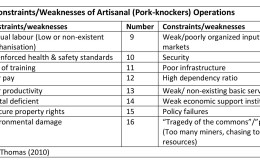
The gold industry in Guyana’s mineral export dependence
Introduction Today’s column continues the discussion of Guyana’s mineral resources extractive dependence.

Introduction Today’s column continues the discussion of Guyana’s mineral resources extractive dependence.

Introduction In order to contextualize the analysis of the opportunities and pitfalls of Guyana’s mineral resources extraction dependence, this week’s column introduces further economic information on the overall performance of the sector.
Introduction As indicated last week, today’s column continues the discussion of risks and pitfalls facing mineral resources extraction in Guyana.
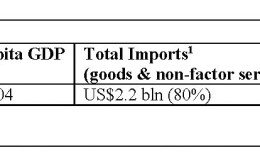
Introduction Having completed discussion of the appropriateness of GDP as a measure of Guyana’s economic size, progress, and national/individual well-being/welfare, I turn now to a broader assessment of Guyana’s development at this particular conjuncture.
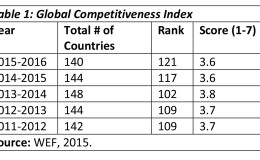
Introduction Following last week’s description of the World Economic Forum’s (WEF), annual Global Competitiveness Index (GCI), today’s column focuses on Guyana’s results.

Introduction Last week I offered the view that for the foreseeable future, the GDP will continue as the premier measure worldwide, and in Guyana, of economic size and progress, as well as national and individual welfare/well-being.
The two preceding columns have presented, firstly, the case made by analysts who believe that, despite its limitations, the GDP remains the most appropriate indicator of economic size, rate of progress and level of welfare or well-being enjoyed by Guyanese.
Introduction Last week’s column responded to the question: Is Guyana’s GDP an appropriate measure of its economic size, progress or well-being?
Introduction Thus far, my reflections on Guyana’s economic statistics have centred on its national accounts, and in particular the GDP.
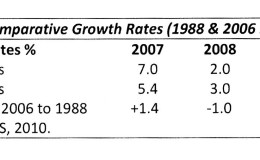
Introduction Presently Guyana’s national accounts are compiled relative to the base year 2006.
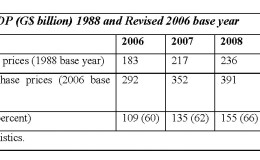
Introduction Let me admit upfront, I agree entirely with Ramesh Gampat’s headline statement as reported in his SN letter of October 26, 2015: `While Guyana’s data is too weak to be subjected to rigorous analysis it allows for broad trends’.
Guyana’s most basic and fundamental economic statistics are its national accounts.
Introduction Last week’s column wrapped-up the series of nine successive contributions arguing for the adoption by Guyana and Caricom, of the United Nations (UN) Post-2015 Development Agenda and the Sustainable Development Goals (SDGs), as their long-term planning and policy frameworks.
Fully supportive This column is the last in a series of nine successive columns devoted to addressing the United Nations (UN) Post-2015 Development Agenda and its related Sustainable Development Goals (SDGs).
In today’s column I shall start addressing the very last topic left in this extended series of discussions on the United Nations (UN) Post-2015 Development Agenda Summit and its related Sustainable Development Goals (SDGs).

Introduction In the previous two columns, I have sought to make the case that, the major impediments, which are constraining the long-term socio-economic/environmental development, and structural transformation of the Region (and Guyana), can be effectively addressed within the framework of the United Nations (UN), Post-2015 Development Agenda and its related Sustainable Development Goals (SDGs, 2015-2030).
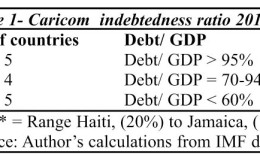
Introduction In last week’s column, I began my response to a question that I have been asked repeatedly in recent times: that is, whether I believe the Sustainable Development Goals, (SDGs), which are slated to be adopted at the United Nations Summit later this month as an integral element of its Post-2015 Development Agenda, offer a sound and adequate planning framework for Caricom and Guyana’s long-term development over its projected life, 2015-30?
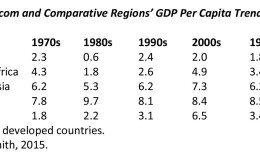
MDGs: Both necessary and sufficient Following on my previous columns that have been assessing the Post-2015 Development Agenda and its accompanying sustainable development goals (SDGs) 2015-2030, which is scheduled to be approved at the upcoming United Nations (UN) Summit (September 24-27) later this year, quite a few readers have asked me a rather pertinent question: whether I believe the SDGs,
Introduction In last week’s column, I sought to provide some insight into elements of the general approach adopted by the intergovernmental Open Working Group (OWG), which the United Nations (UN) had created to produce a Post-2015 Development Agenda that is to be agreed upon at the upcoming UN summit, to be held later in September of this year.
Introduction From Guyana’s perspective, today’s column continues to focus on an evaluation of the Sustainable Development Goals (SDGs) 2015-2030, their 169 targets and 304 indicators of compliance, which are scheduled to be agreed upon by all 193 member states of the United Nations (UN) at their upcoming summit on September 25-27 this year.
The ePaper edition, on the Web & in stores for Android, iPhone & iPad.
Included free with your web subscription. Learn more.